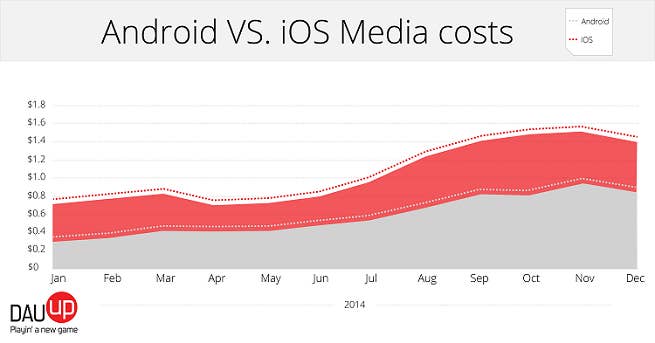DAU-UP study finds Android ARPU now equaling iOS
Factoring in media costs for acquisition brings platforms level on LTV says firm
Data analysis from Israeli firm DAU-UP has indicated that ARPU for Android games is approaching, and at times exceeding, that for those on iOS.
That might seem to contradict data seen elsewhere, but DAU-UP believes its methodology considers some costs not included elsewhere - namely the buying of media space in other apps and elsewhere. Once the media costs for user acquisition are accounted for, publishing on Android starts to look like a much more appealing proposition than it might have previously.
"After years of being the unwanted step child, Android is having its Cinderella moment, as game developers are increasing their Android development resources to meet the growth in Android revenue," said Idan Nizri, DAU-UP's founder and CEO. "We're hearing more and more developers developing games 'Android First'. I have no doubt that game developers will invest more time, effort and resources in Android in 2015."

"ARPU for Android games increased from 25 per cent of the ARPU of iOS games in Q1 2014 to approximately 65 per cent of the ARPU of iOS games now, a greater than 100 per cent increase in the Lifetime Value (LTV) of Android users," says DAU-UP. "When factoring the media costs, which are 20-50 per cent lower for acquiring players on Android devices, the ROI for players of Android Games is now equal to or sometimes better than iOS games."
Whilst LTV for Android is still lower, then, the expenditure per player saves enough to begin to even things out. The figures show that peak acquisition costs for both platforms in 2014 were around November, before dipping a little in December, but this is likely merely a seasonal effect, as new owners populate devices with games, rather than a continuing trend.

A tripling of Android user LTV over the course of a year is extremely significant, particularly at a time when acquisition, retention and monetisation are becoming ever harder. DAU-UP sees several factors affecting this trend.
- Improvement in the quality of Android devices has resulted in more mid-core and hard-core gamers switching to the more powerful Android devices
- Advancements in the quality, user interface and system stability of the Android OS
- Trend of early adopters migrating to Android smartphones
- Continued growth for Android smartphones among mid-adopters, the largest and biggest spending segment of gamers
- Stronger Android growth in emerging Latin American and Asia-Pacific markets
- Greater/earlier resource allocation for Android games by game developers - with some even developing 'Android First' instead of the previous 'iOS First'
"Numbers don't lie," added Nizri. "What these numbers show is that the quality, functionality and usability of Android devices has improved over the last 18 months, and users, including high end users and active gamers, have responded by buying and playing on Android devices. And as more gamers play on Android devices, developers commit more resources to take advantage of the growing Android market."
Whilst DAU-Up's figures do have a geographical skew, they are also taken worldwide. 50 per cent of the 10 million gamers in the study are North American and 30 per cent European. Ten per cent are taken from each of the Latin American and Asian-Pacific markets.

